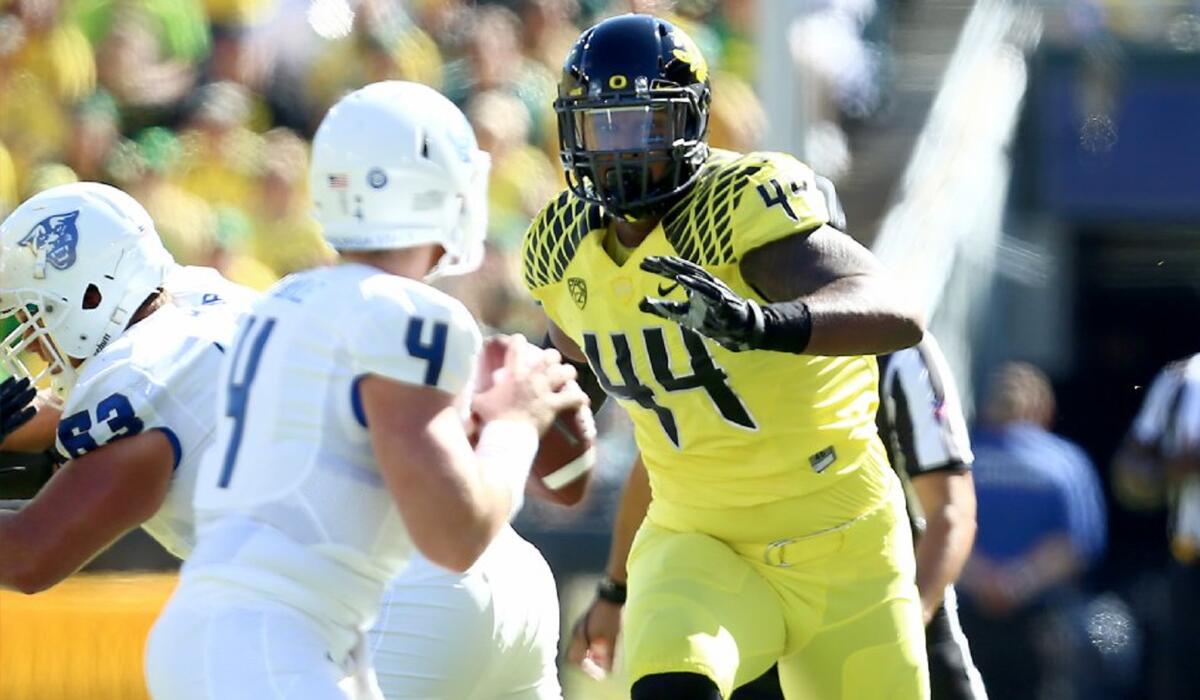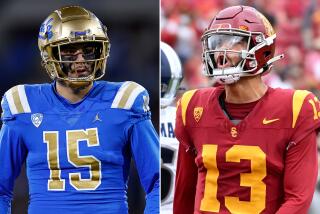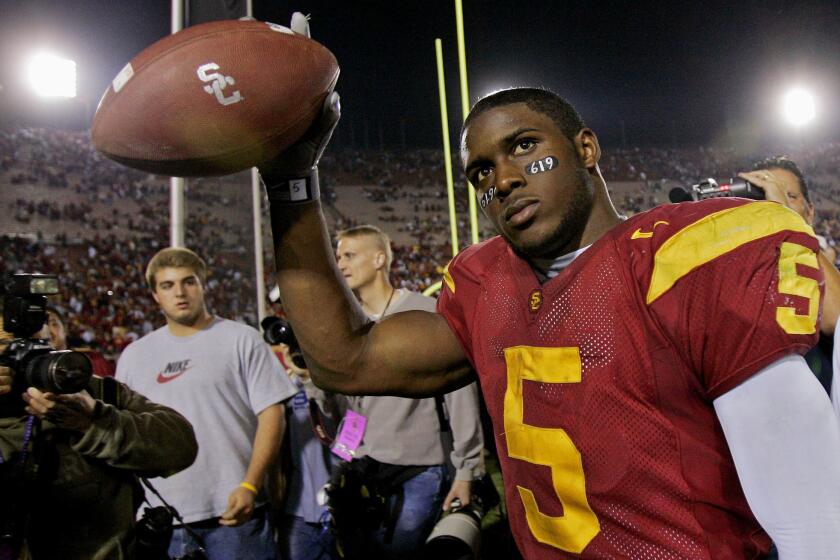Teams figure to show more than passing interest in interior defensive lineman in Thursday’s NFL draft

Oregon defensive lineman DeForest Buckner (44) charges after the Georgia State quarterback in the first half on Sept. 19.
The NFL is a passing league, so it’s only fitting that quarterbacks will be front and center Thursday for the opening round of the draft in Chicago. California’s Jared Goff is likely to go first to the Rams, followed by North Dakota State’s Carson Wentz to the Philadelphia Eagles.
But it won’t be long until the spotlight shifts to the other side of the football, with defense coming into sharp focus — specifically those players who can chase down said quarterbacks and disrupt plays before they can fully unfold.
As the Denver Broncos demonstrated in Super Bowl 50, a rock-solid defense can ultimately decide which team summits the NFL mountaintop.
This class of prospects is particularly rich in interior defensive linemen, those man-mountains in the middle who can cave in pockets on one play, and stop running backs cold in their tracks on the next.
“The who league has been talking about it,” said Mike Mayock, an NFL Network draft analyst who said this is the deepest class at that position in memory. Interior linemen comprise defensive tackles, nose tackles and five-technique defensive ends — basically any down lineman positioned between the offensive tackles, but not edge rushing defensive ends and outside linebackers.
During the last five years, Mayock said, an average of 11 interior defensive linemen per year have been selected in the first three rounds of the draft. This year, he counts 18 who should go in that range.
Among the standouts are Oregon’s DeForest Buckner, potentially a top-five pick, who is listed as a defensive end but could play that in a 3-4 defense, meaning he would line up in the interior area; defensive tackles A’Shawn Robinson and Jarran Reed of Alabama; Sheldon Rankins of Louisville; Kenny Clark of UCLA; Andrew Billings of Baylor, and the spectacularly talented but trouble-prone Robert Nkemdiche of Mississippi.
Paradoxically, because this draft class is so deep at that position, there might be fewer than usual taken in the opening round. Teams on the hunt for an interior defensive lineman could have the luxury of waiting.
“If you’re in the second half of the first round and you need a wide receiver, and you know it’s not a very deep class for those, you’re probably going to go get one,” Mayock said. “Same for offensive tackles. I think you’re going to see a run on some of those positions that are weak, and teams are going to come back later and get their defensive tackle.
“The best way I heard it put is a GM said to me, ‘I could draft a guy in the fourth round this year that would typically be a second- or third-round player.”
It might just be a statistical anomaly that there are so many solid interior defensive linemen in this class, rather than some trend in college football that is trickling up to the NFL. But there is no question teams are looking for those types of players, who can both rush the passer and stop the run.
Denver was an ideal example of that, because the Broncos not only got pass-rush pressure from Von Miller and DeMarcus Ware on the outside, but from Malik Jackson and Derek Wolfe. The Broncos beat Carolina, 24-10, in the Super Bowl — also an outstanding defensive game for the Panthers — and put the clamps on quarterback Cam Newton, the league’s most valuable player.
Not surprisingly, teams around the league study that blueprint and copy what they can.
“You look at what the Denver Broncos have done and the resources they invested in their defense the last five years, and the majority of their early round picks have been on defense,” Jacksonville Jaguars General Manager Dave Caldwell said. “That’s probably the plan we’ll follow.”
Because so many NFL offenses are putting three and four wide receivers on the field, defenses are forced to respond with “sub” packages — as opposed to their base schemes — and take a defensive lineman or linebacker off the field while adding a defensive back. Mayock said that defenses are using sub packages on 60-70% of snaps, as opposed to a decade ago when base packages were used the vast majority of the time.
As a result, teams have to do more with less when it comes to defensive linemen, and therefore it’s vital to have a down lineman who can both stop the run and pressure the quarterback. Hence, defenses tend to be getting smaller, quicker and more athletic up front.
“We’re looking to rush and disrupt quarterbacks,” Oakland Raiders Coach Jack Del Rio said. “We don’t want them to be comfortable there or sit back, pat the ball and go to different reads. The more you can eliminate that time, the more effective and efficient your defense will be.”
Clark is confident he can be one of those hybrid players, and do on Sundays for an NFL team what he did on Saturdays for UCLA. He has studied the playing style of All-Pro defensive tackle Haloti Ngata, who played his first nine seasons in Baltimore before being traded to Detroit in 2015.
“His whole style of play is great,” Clark said of Ngata, 32. “He gets off the ball quick. He’s explosive, especially at the age he’s at now. He’s still doing his thing, still knocking guys back and being disruptive. That’s impressive.”
Rankins points to Rams defensive tackle Aaron Donald, who two years ago was defensive rookie of the year, and last season made a strong case for defensive player of the year, an award that ultimately went to Houston’s J.J. Watt.
“If he’s not making the play, you know where he’s at,” Rankins said of Donald. “Everybody on the field knows where he is and has to account for him. If not, he’ll make the play.”
Twitter: @LATimesfarmer
More to Read
Get our high school sports newsletter
Prep Rally is devoted to the SoCal high school sports experience, bringing you scores, stories and a behind-the-scenes look at what makes prep sports so popular.
You may occasionally receive promotional content from the Los Angeles Times.







